The intimidating mathematical hurdle a beaten down stock market always clears 🙌
Plus a charted review of the macro crosscurrents 🔀
📈The stock market climbed last week, with the S&P 500 rising 1.7% to close at 6,664.01. The index is now down 1.3% from its Oct. 8 closing high of 6,753.72 and up 13.3% year-to-date. For more on recent market moves, read: The stock market and the economy are diverging 📊
-
A TKer subscriber recently pointed out that if your investment is down 20%, then you’d need a 25% gain from the current level to return to the initial level.
For example, if your investment of $100 falls 20% (or $20), then you will have an asset worth $80. To return to breakeven, the value of your $80 asset would need to increase by 25% (or $20).
This is a helpful way of thinking about investing as you look at the red and green arrows in your portfolio. It keeps your math sharp while reminding you that earning a positive return is not an easy process.
As the losses get bigger, the required percentage return rises at an increasing rate. A 33% loss would have to be followed by a 50% gain. Hedge fund legend Ray Dalio often reminds followers, “If you lose 50%, you’ve got to make 100% to get back.“
Hopefully, this grade-school math doesn’t scare you away from investing in the stock market. History repeatedly shows that the market always clears that intimidating-sounding hurdle before facing its next major decline.
This great chart from Creative Planning’s Charlie Bilello helps us understand the stock market’s remarkable ability to recover from setbacks. It tracks history’s bull and bear markets with annotations for percentage gains and losses as measured by total returns.
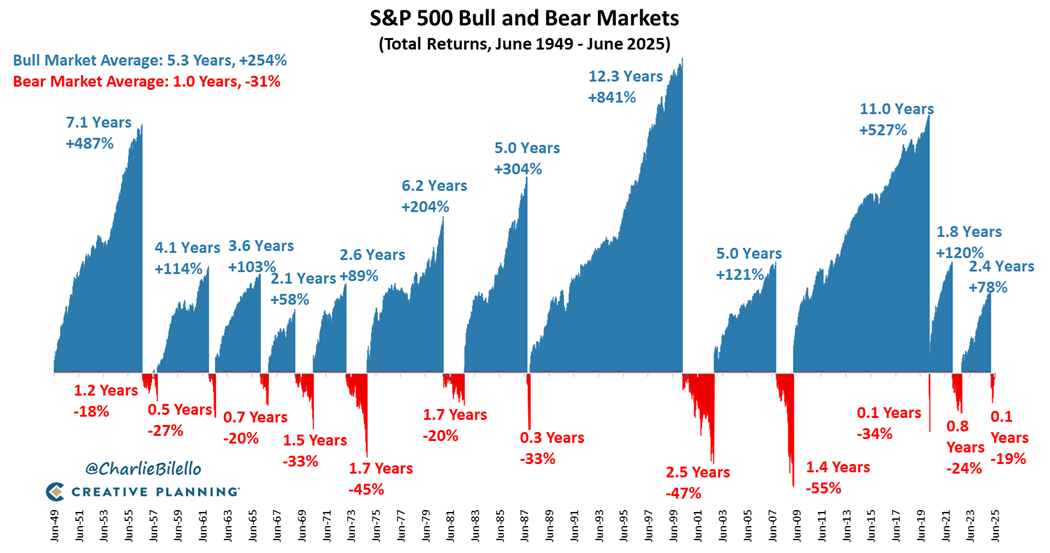
Some highlights from history:
The 2022 bear market brought a 24% decline. That means we needed a 32% gain to break even. We got a 78% total return before the market rout earlier this year.
The 2020 pandemic crash saw the S&P 500 fall 34%. We needed a 52% return to break even. We got a 120% return.
The global financial crisis starting in 2007 sent the market down a whopping 55%. We needed a 122% return to break even. We got an 11-year bull market that returned 527%.
The average bear market saw stocks fall 31%. A 45% return would get you to break even. But the average bull market has given us a 254% return before facing its next bear market.
All those instances of 100%+ returns speak to TKer Stock Market Truth No. 4: Stocks offer asymmetric upside.
To be clear, we’re talking about broadly diversified indexes like the S&P 500. (In fact, Dalio often uses this math to make the case for diversification.)
While it is true that the stock market usually goes up, most individual stocks underperform. It’s the hard-to-identify handful of stocks generating extraordinary upside that drives market returns higher.
The big picture 🖼️
There’s no shortage of reasons why investing in the stock market can be challenging and treacherous. You don’t have to look far to find someone explaining why you shouldn’t be in the market. Bearishness sells.
But when investing feels scary, it’s good to look for the facts in the data.
And the fact is that while the market seems to constantly face insurmountable challenges, it always manages to … surmount those challenges.
-
Related from TKer:
Review of the macro crosscurrents 🔀
There were several notable data points and macroeconomic developments since our last review:
🚨Due to the government shutdown, we are not getting economic data from federal agencies, including the Census Bureau, the Bureau of Labor Statistics, and the Bureau of Economic Analysis. Until the government reopens, we’ll be leaning more on private sources of data.
🏦 America’s bankers see economic growth, but also uncertainty. Here’s JPMorgan Chase CEO Jamie Dimon in the bank’s Q3 earnings announcement: “While there have been some signs of a softening, particularly in job growth, the U.S. economy generally remained resilient. However, there continues to be a heightened degree of uncertainty stemming from complex geopolitical conditions, tariffs and trade uncertainty, elevated asset prices and the risk of sticky inflation. As always, we hope for the best, but these complex forces reinforce why we prepare the Firm for a wide range of scenarios.”
Here’s Wells Fargo CEO Charlie Scharf: “While some economic uncertainty remains, the U.S. economy has been resilient and the financial health of our clients and customers remains strong. Spending on debit and credit cards continued to increase, auto loan originations had strong growth from a year ago, and total client assets in our Wealth and Investment Management business continued to grow.”
Here’s Bank of America CFO Alastair Borthwick: “We do see in our data that the consumer is spending more and that feels consistent with a growth economy.“
💳 Card spending data is holding up. From JPMorgan: “As of 10 Oct 2025, our Chase Consumer Card spending data (unadjusted) was 5.0% above the same day last year. Based on the Chase Consumer Card data through 10 Oct 2025, our estimate of the US Census September control measure of retail sales m/m is 0.13%.
From BofA: “Total card spending per HH was up 3.7% y/y in the week ending Oct 11, according to BAC aggregated credit & debit card data. Y/y spending growth saw the biggest rise in general merchandise, department stores, clothing & online retail since last week. This spending surge was either a result of higher prices during Prime Day due to tariffs or very strong demand.”
For discussion on how sales may be inflated due to tariffs, read: A BIG economic question right now 🤔
🎄 Job searches for the holiday season are up. From Indeed: “Job seeker interest in seasonal work was up 27% year-over-year at the end of September, and 50% above 2023 levels.“
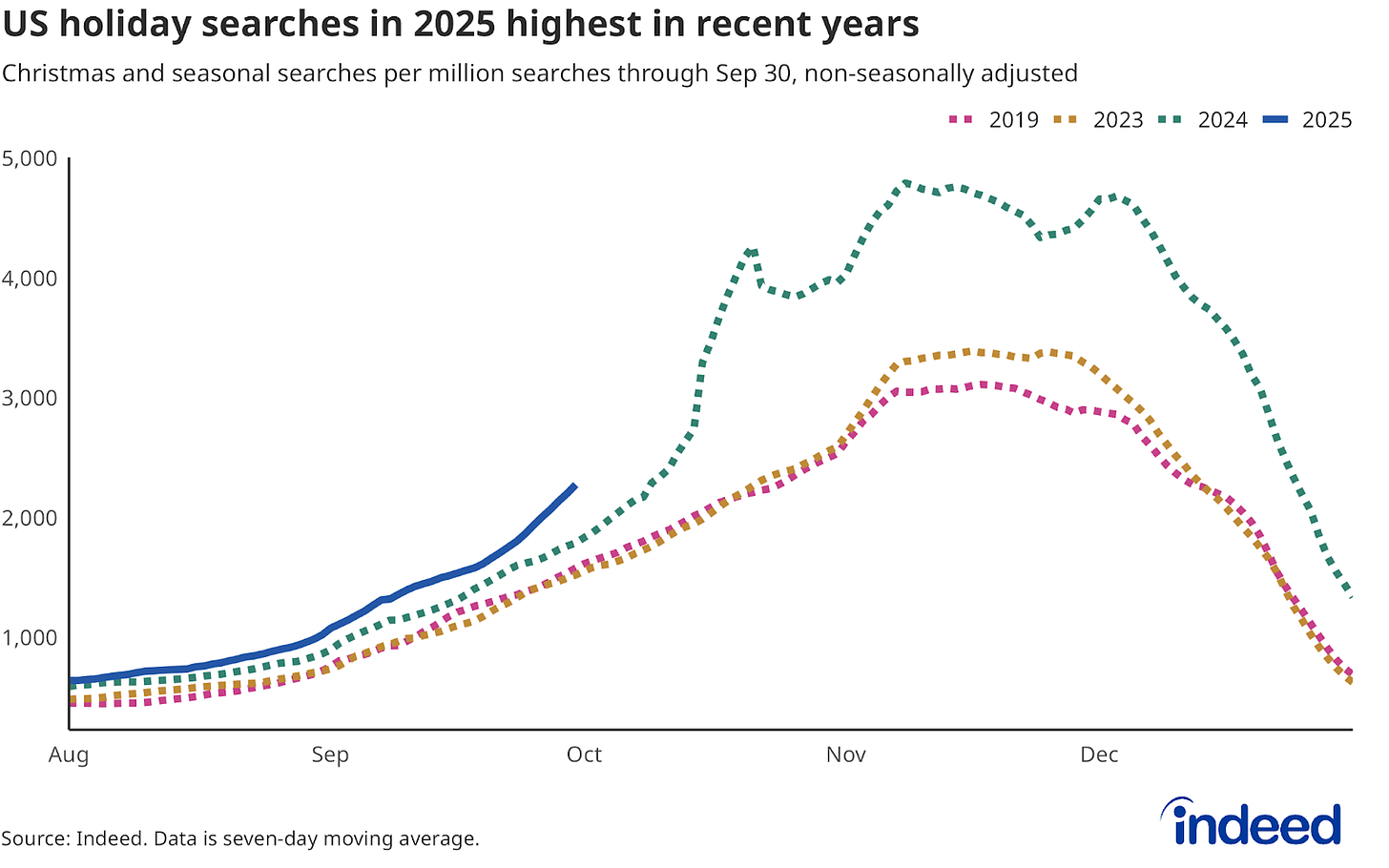
“Postings for seasonal work were also up from a year ago, but by a much more modest 2.7%.“
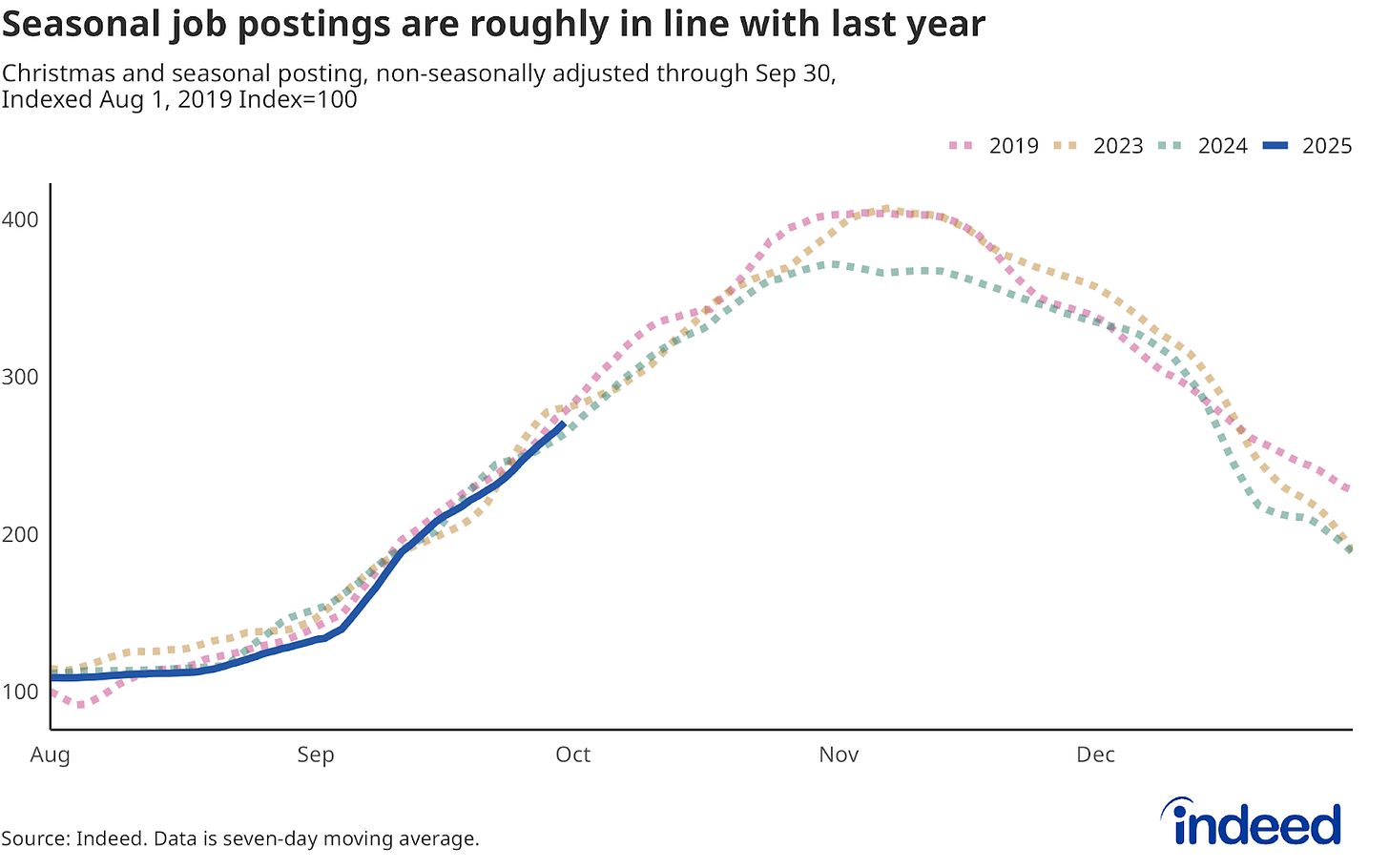
For more on the labor market, read: 9 once-hot economic charts that cooled 📉 and We’re at an economic tipping point ⚖️
💻 Google searches for jobs are elevated. From Jessica Rabe, co-founder of Datatrek Research: “Searches for ‘find job’ are now at a 20-year high, surpassing the prior peak in January 2008 during the Great Recession. This chart perfectly encapsulates why Chair Powell is so concerned about the current ‘low hire, low fire’ labor market environment. Even when adjusting for working-age population growth (about 12 percent since 2008), Americans are searching for jobs at very near recessionary levels, so a pickup in layoffs would surely increase unemployment.“
👎 Small business optimism ticks lower. The NFIB’s Small Business Optimism Index declined to 98.8 in September from 100.8 in August. From the NFIB: “While most owners evaluate their own business as currently healthy, they are having to manage rising inflationary pressures, slower sales expectations, and ongoing labor market challenges. Although uncertainty is high, small business owners remain resilient as they seek to better understand how policy changes will impact their operations.”

For more on the disconnect between soft and hard economic data, read: 4 sometimes-conflicting ways I’m thinking about the economy 😬😞😎🙃 and Beware how your politics distort how you perceive economic realities 😵💫
👎 Small businesses are worried about tariffs. Also from the NFIB: “In September, the percent of small business owners reporting labor quality as the single most important problem for their business fell 3 points to 18%, tying with taxes as the top problem.”
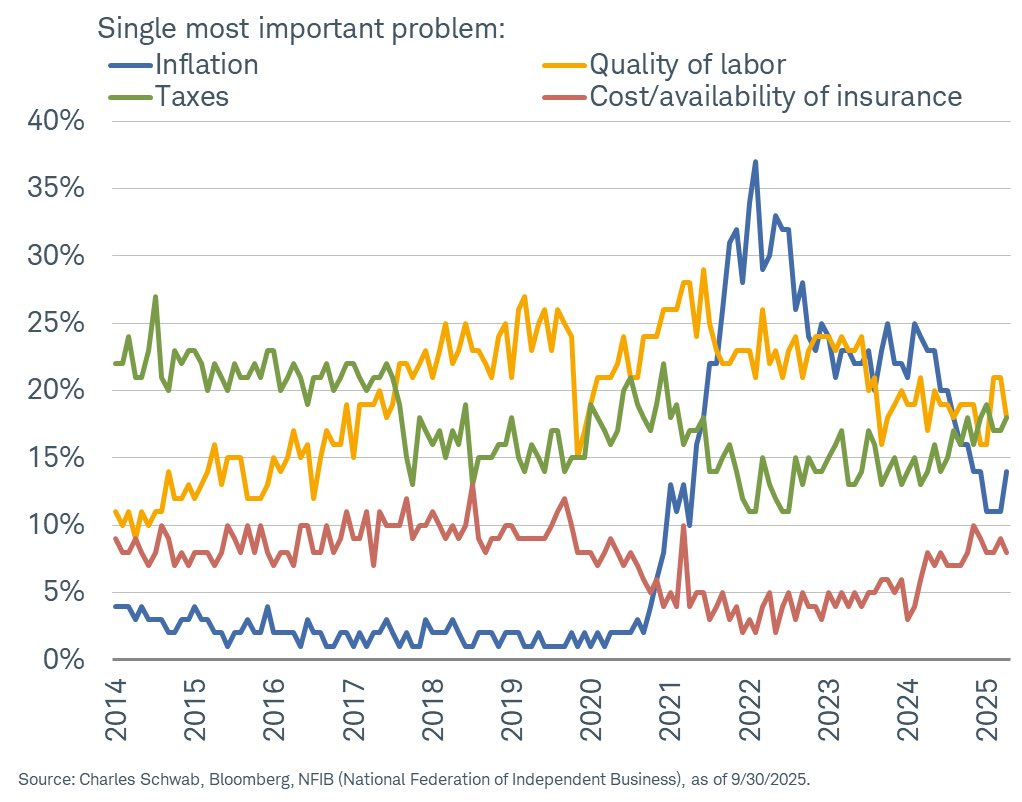
Schwab’s Liz Ann Sonders notes that the small-business respondents likely lump tariffs into the “taxes” category.
💸 Consumers are expected to pay for tariffs. From Goldman Sachs: “We estimate the distribution of tariff costs among foreign exporters, US businesses, and US consumers using detailed data on import and consumer prices. We find that import prices of goods hit with larger tariff increases have fallen disproportionately relative to prior trends. This means that foreign exporters are absorbing some of the tariff cost, unlike in 2019, though some of the decline likely reflects underreporting of import value to evade tariffs. We also find that consumer prices have risen disproportionately relative to prior trends in categories facing larger tariff increases. Passthrough to consumer prices has reached 55% after six months, meaningfully lower than at the same point in 2019.“
This is expected to affect inflation readings: “Our analysis implies that tariff effects have raised core PCE prices by 0.44% so far this year. Our forecast of additional tariffs combined with our baseline assumption that peak passthrough will rise further from 55% to 70% implies a further 0.6% boost from tariffs through next year, leaving core PCE inflation at 3.0% year-over-year in December 2025 (or 2.2% net of tariff effects) and 2.4% in December 2026 (or 2% net of tariff effects).“
For more, read: Keep an eye on tariffs 👀
⛽️ Gas prices tick lower. From AAA: “The national average for a gallon of regular gasoline could reach the 3-dollar mark for the first time in 4 years. Since last week, the national average has dropped more than 5 cents to $3.05. Several factors are behind the drop, including falling crude oil prices, lower gasoline demand, and cheaper winter-blend gasoline at the pump. The tropics have been relatively quiet, and storm activity hasn’t had an impact on gas prices.”
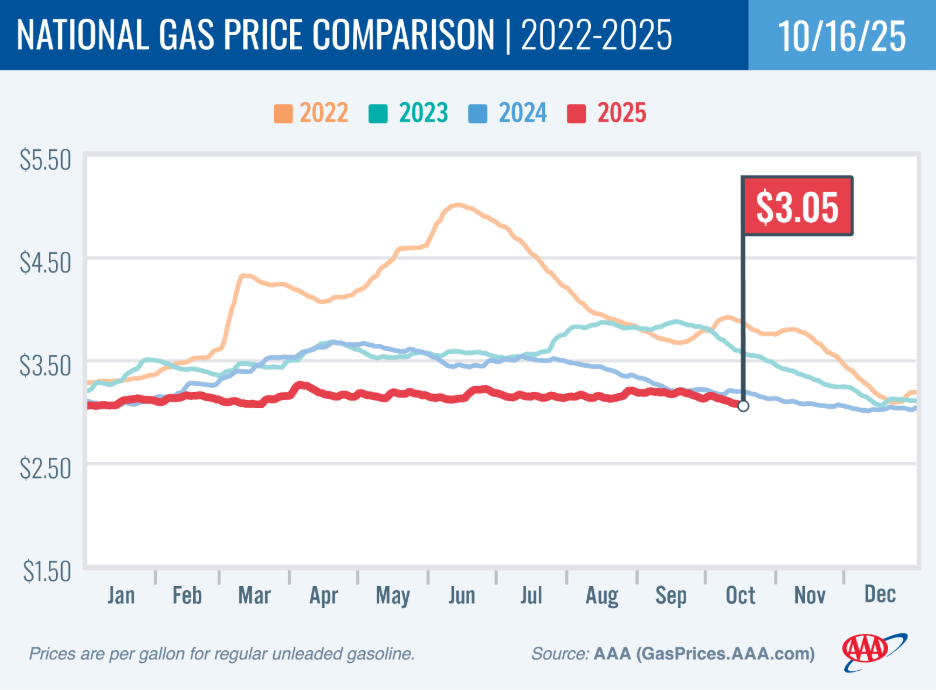
For more on energy prices, read: Higher oil prices meant something different in the past 🛢️
👎 Business leaders in the northeast U.S. are concerned. From the NY Fed’s October Business Leaders Survey: “Business activity declined substantially in the New York-Northern New Jersey region’s service sector in October. Employment edged lower. Firms generally do not expect conditions to improve in the months ahead.“
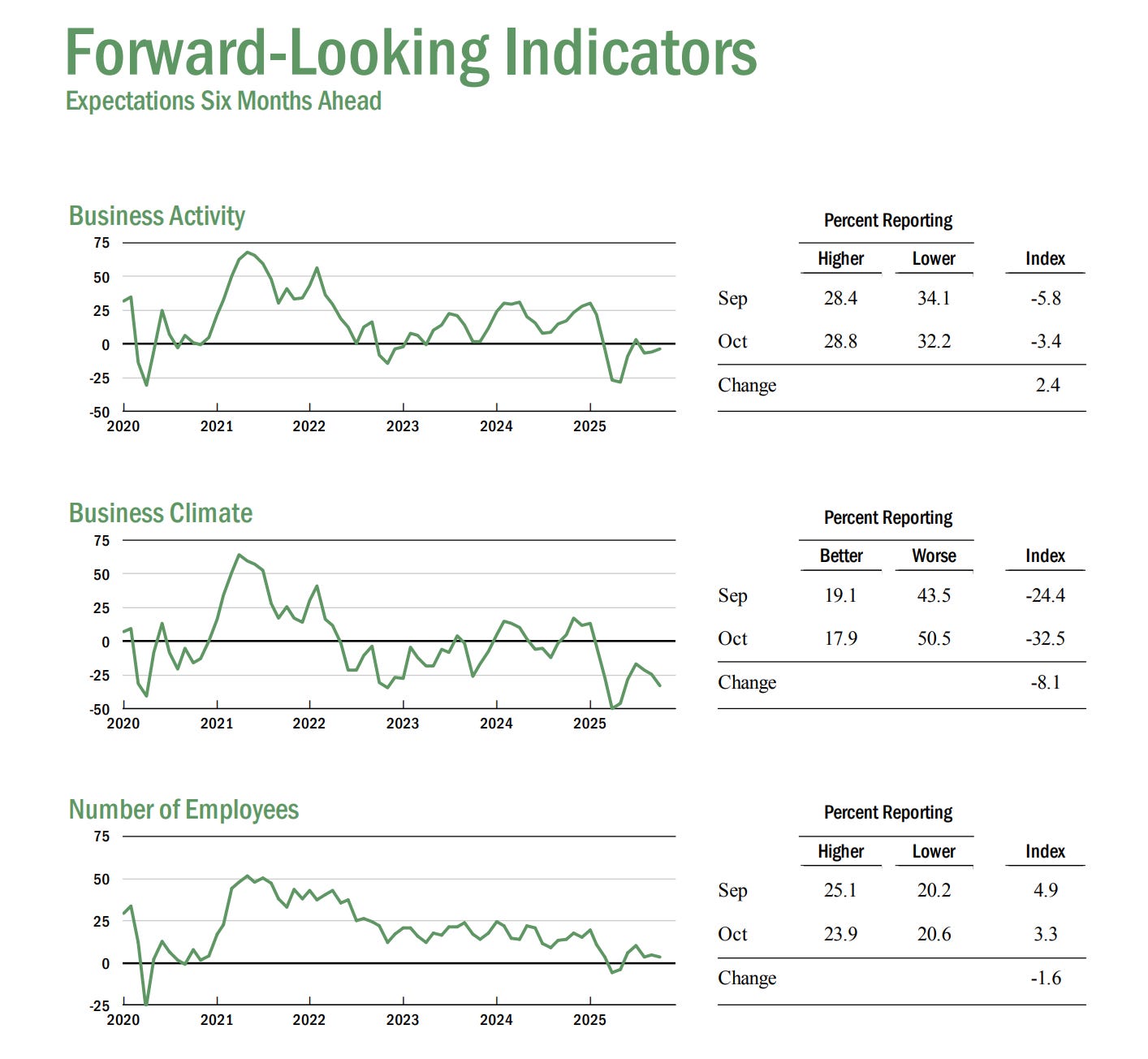
👍 New York area manufacturers say things are looking up. From the NY Fed’s October Empire State Manufacturing Survey: “The headline general business conditions index climbed nineteen points to 10.7, its third positive reading in the last four months. New orders edged higher and shipments increased. Delivery times were slightly longer, and supply availability continued to worsen somewhat. Inventories were little changed. Employment increased, while the average workweek was slightly lower. The pace of both input price increases and selling price increases picked up. Capital spending plans remained soft. Firms grew more optimistic about the outlook, with close to half expecting conditions to improve in the months ahead.”

👎 Philadelphia area manufacturers say things aren’t great, but could improve. From the Philly Fed’s October Manufacturing Business Outlook Survey: “The survey’s index for current general activity fell significantly and turned negative, more than offsetting last month’s increase. The shipments index declined but remained positive, while the new orders index rose. The employment index ticked down but continued to reflect overall increases in employment. Both price indexes moved higher and remain elevated. The survey’s future indicators suggest widespread expectations for growth over the next six months.”
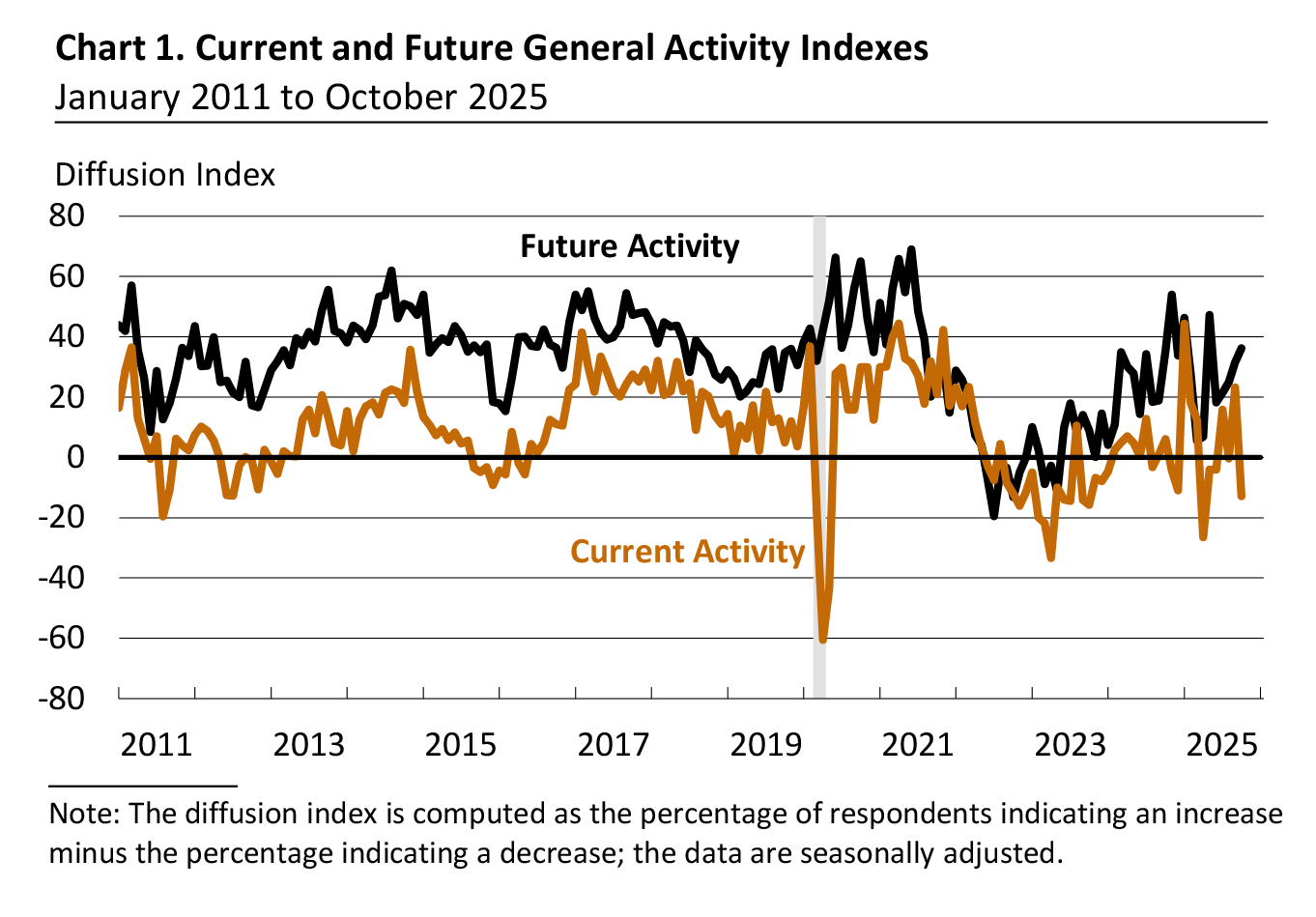
Keep in mind that during times of perceived stress, soft survey data tends to be more exaggerated than actual hard data.
For more on this, read: What businesses do > what businesses say 🙊
💰 Weekly mortgage applications decline. From Mortgage Bankers Association’s Joel Kan: “Purchase activity for new homes continued to run ahead of last year’s pace, showing a 2% annual increase. Applications were down over the month, but were consistent with typical seasonal patterns for September. Despite more inventory, builder incentives, and lower mortgage rates, near-term demand is slowing as the labor market weakens.”
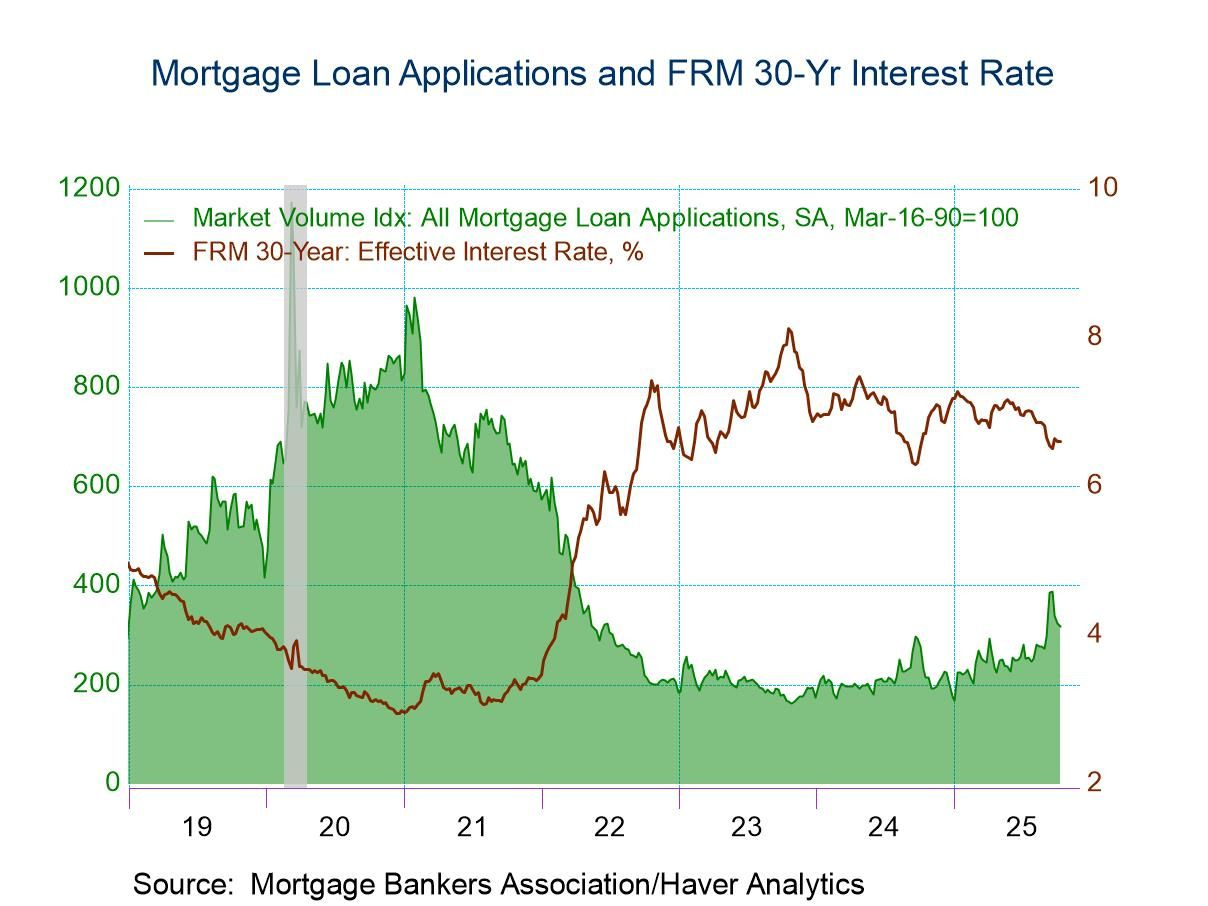
🏠 Mortgage rates tick lower. According to Freddie Mac, the average 30-year fixed-rate mortgage declined to 6.27%, down from 6.30% last week: “Mortgage rates inched down this week and have held relatively steady over the past several weeks. Importantly, homeowners have noticed these consistently lower rates, driving an uptick in refinance activity. Combined with increased housing inventory and slower house price growth, these rates also are creating a more favorable environment for those looking to buy a home.”
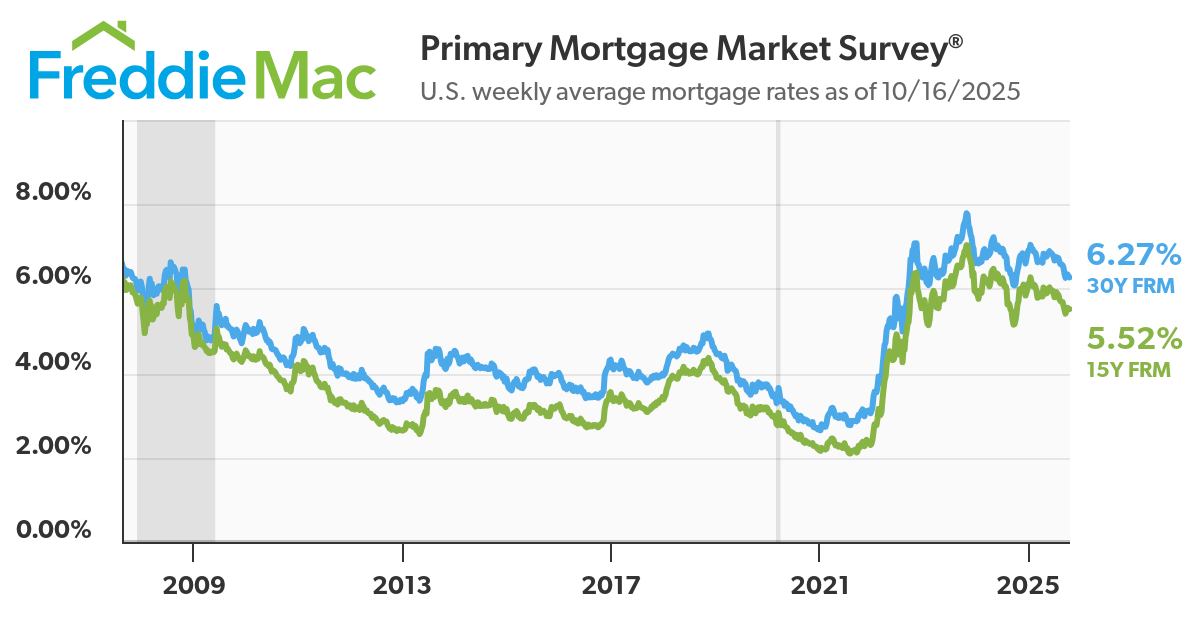
There are 147.9 million housing units in the U.S., of which 86.1 million are owner-occupied and about 39% are mortgage-free. Of those carrying mortgage debt, almost all have fixed-rate mortgages, and most of those mortgages have rates that were locked in before rates surged from 2021 lows. All of this is to say: Most homeowners are not particularly sensitive to the small weekly movements in home prices or mortgage rates.
For more on mortgages and home prices, read: Why home prices and rents are creating all sorts of confusion about inflation 😖
🏠 Homebuilder sentiment improves. From the NAHB: “While recent declines for mortgage rates are an encouraging sign for affordability conditions, the market remains challenging. The housing market has some areas with firm demand, including smaller builders shifting to remodeling and ongoing solid conditions for the luxury market. However, most home buyers are still on the sidelines, waiting for mortgage rates to move lower.”

😬 This is the stuff pros are worried about. From BofA’s October Global Fund Manager Survey: “On risks … 33% of FMS investors view an AI equity bubble as the biggest tail risk for the first time in the history of FMS tail risks, up from 11% last month. … Note trade war risk (5%) has eased significantly since peaking in April (then, a record 80% FMS investors identified it as the #1 biggest tail risk).”
For more on risks, read: Three observations about uncertainty in the markets 😟 and Two times when uncertainty seemed low and confidence was high 🌈
📈 Near-term GDP growth estimates are tracking positively. The Atlanta Fed’s GDPNow model sees real GDP growth rising at a 3.9% rate in Q3.
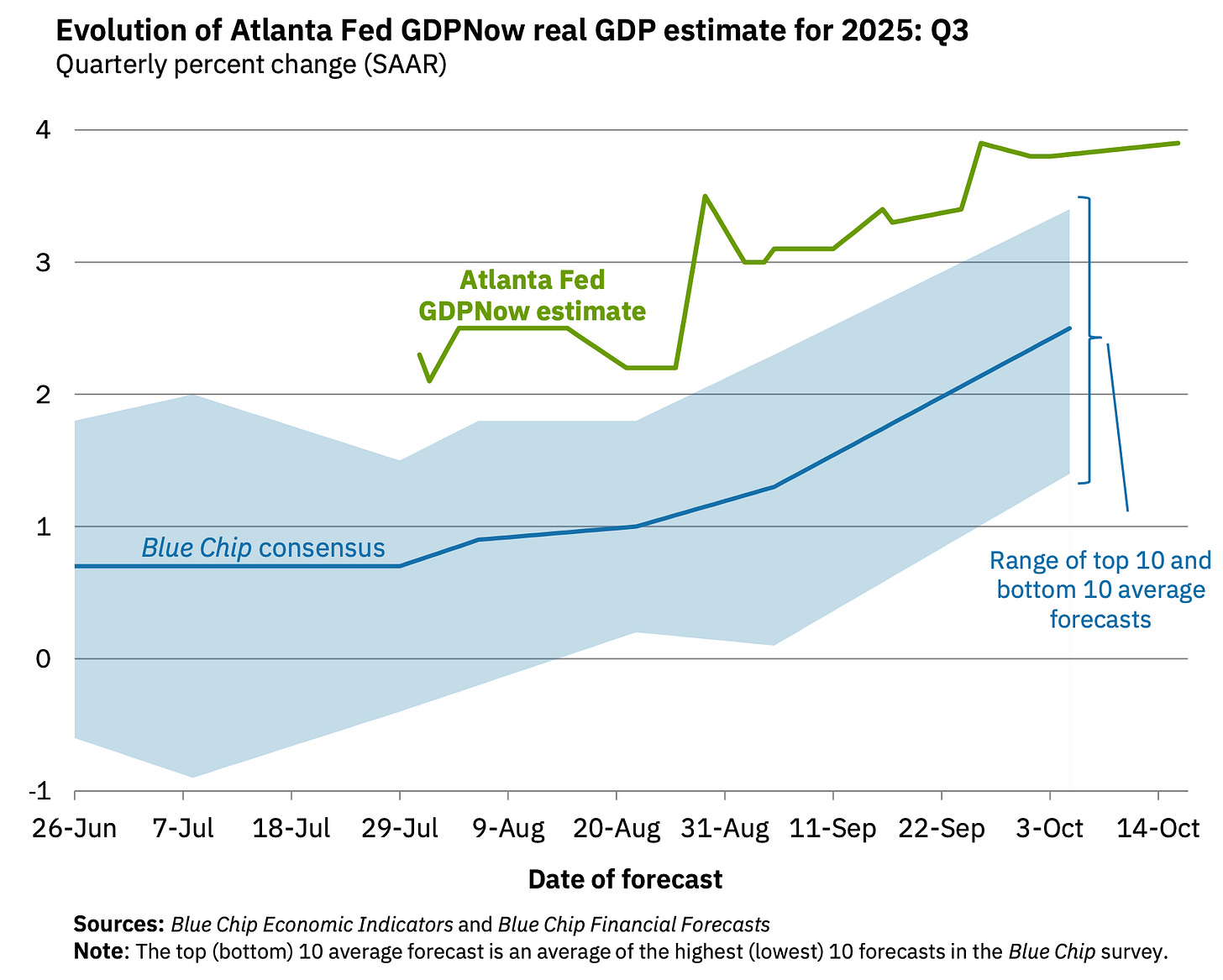
For more on GDP and the economy, read: 9 once-hot economic charts that cooled 📉 and We’re at an economic tipping point ⚖️
Putting it all together 📋
🚨 The Trump administration’s pursuit of tariffs is disrupting global trade, with significant implications for the U.S. economy, corporate earnings, and the stock market. Until we get more clarity, here’s where things stand:
Earnings look bullish: The long-term outlook for the stock market remains favorable, bolstered by expectations for years of earnings growth. And earnings are the most important driver of stock prices.
Demand is positive: Demand for goods and services remains positive, supported by healthy consumer and business balance sheets. Job creation, although cooling, also remains positive, and the Federal Reserve — having resolved the inflation crisis — shifted its focus toward supporting the labor market.
But growth is cooling: While the economy remains healthy, growth has normalized from much hotter levels earlier in the cycle. The economy is less “coiled” these days as major tailwinds like excess job openings and core capex orders have faded. It has become harder to argue that growth is destiny.
Actions speak louder than words: We are in an odd period, given that the hard economic data decoupled from the soft sentiment-oriented data. Consumer and business sentiment has been relatively poor, even as tangible consumer and business activity continues to grow and trend at record levels. From an investor’s perspective, what matters is that the hard economic data continues to hold up.
Stocks are not the economy: There’s a case to be made that the U.S. stock market could outperform the U.S. economy in the near term, thanks largely to positive operating leverage. Since the pandemic, companies have aggressively adjusted their cost structures. This came with strategic layoffs and investment in new equipment, including hardware powered by AI. These moves are resulting in positive operating leverage, which means a modest amount of sales growth — in the cooling economy — is translating to robust earnings growth.
Mind the ever-present risks: Of course, we should not get complacent. There will always be risks to worry about, such as U.S. political uncertainty, geopolitical turmoil, energy price volatility, and cyber attacks. There are also the dreaded unknowns. Any of these risks can flare up and spark short-term volatility in the markets.
Investing is never a smooth ride: There’s also the harsh reality that economic recessions and bear markets are developments that all long-term investors should expect as they build wealth in the markets. Always keep your stock market seat belts fastened.
Think long-term: For now, there’s no reason to believe there’ll be a challenge that the economy and the markets won’t be able to overcome over time. The long game remains undefeated, and it’s a streak that long-term investors can expect to continue.
For more on how the macro story is evolving, check out the previous review of the macro crosscurrents. »
Key insights about the stock market 📈
Here’s a roundup of some of TKer’s most talked-about paid and free newsletters about the stock market. All of the headlines are hyperlinked to the archived pieces.
10 truths about the stock market 📈
The stock market can be an intimidating place: It’s real money on the line, there’s an overwhelming amount of information, and people have lost fortunes in it very quickly. But it’s also a place where thoughtful investors have long accumulated a lot of wealth. The primary difference between those two outlooks is related to misconceptions about the stock market that can lead people to make poor investment decisions.
The makeup of the S&P 500 is constantly changing 🔀
Passive investing is a concept usually associated with buying and holding a fund that tracks an index. And no passive investment strategy has attracted as much attention as buying an S&P 500 index fund. However, the S&P 500 — an index of 500 of the largest U.S. companies — is anything but a static set of 500 stocks.

The key driver of stock prices: Earnings💰
For investors, anything you can ever learn about a company matters only if it also tells you something about earnings. That’s because long-term moves in a stock can ultimately be explained by the underlying company’s earnings, expectations for earnings, and uncertainty about those expectations for earnings. Over time, the relationship between stock prices and earnings has a very tight statistical relationship.
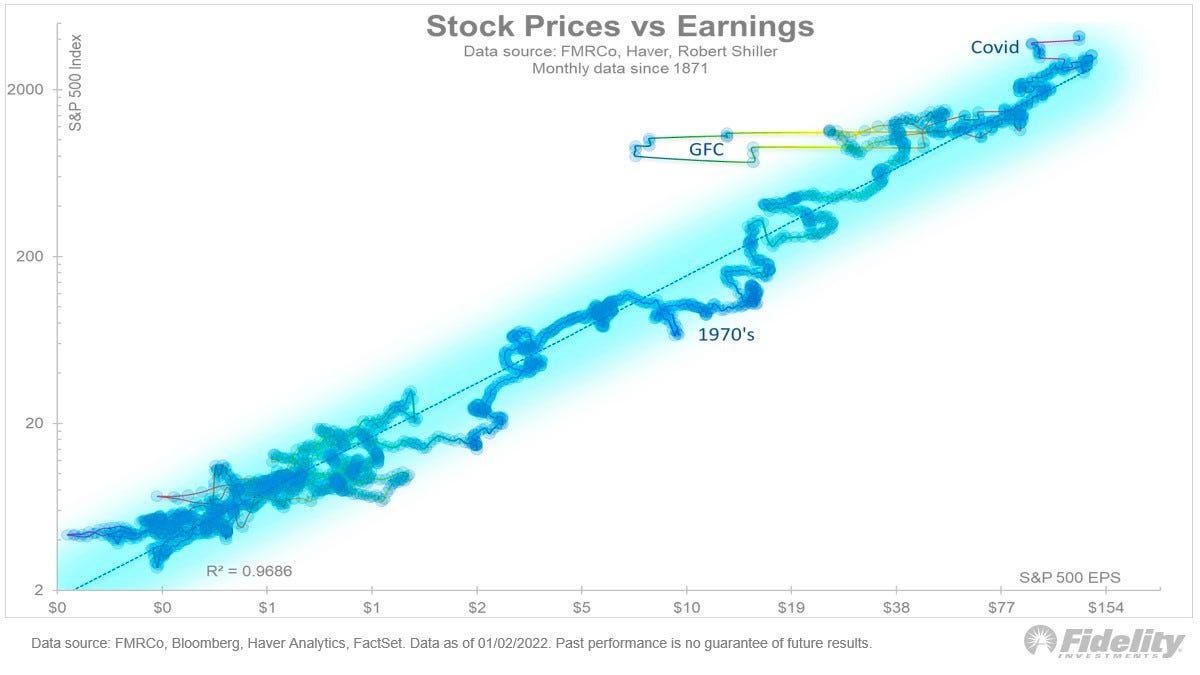
Stomach-churning stock market sell-offs are normal🎢
Investors should always be mentally prepared for some big sell-offs in the stock market. It’s part of the deal when you invest in an asset class that is sensitive to the constant flow of good and bad news. Since 1950, the S&P 500 has seen an average annual max drawdown (i.e., the biggest intra-year sell-off) of 14%.
How the stock market performed around recessions 📉📈
Every recession in history was different. And the range of stock performance around them varied greatly. There are two things worth noting. First, recessions have always been accompanied by a significant drawdown in stock prices. Second, the stock market bottomed and inflected upward long before recessions ended.

In the stock market, time pays ⏳
Since 1928, the S&P 500 has generated a positive total return more than 89% of the time over all five-year periods. Those are pretty good odds. When you extend the timeframe to 20 years, you’ll see that there’s never been a period where the S&P 500 didn’t generate a positive return.

What a strong dollar means for stocks 👑
While a strong dollar may be great news for Americans vacationing abroad and U.S. businesses importing goods from overseas, it’s a headwind for multinational U.S.-based corporations doing business in non-U.S. markets.

Stanley Druckenmiller's No. 1 piece of advice for novice investors 🧐
…you don't want to buy them when earnings are great, because what are they doing when their earnings are great? They go out and expand capacity. Three or four years later, there's overcapacity and they're losing money. What about when they're losing money? Well, then they’ve stopped building capacity. So three or four years later, capacity will have shrunk and their profit margins will be way up. So, you always have to sort of imagine the world the way it's going to be in 18 to 24 months as opposed to now. If you buy it now, you're buying into every single fad every single moment. Whereas if you envision the future, you're trying to imagine how that might be reflected differently in security prices.
Peter Lynch made a remarkably prescient market observation in 1994 🎯
Some event will come out of left field, and the market will go down, or the market will go up. Volatility will occur. Markets will continue to have these ups and downs. … Basic corporate profits have grown about 8% a year historically. So, corporate profits double about every nine years. The stock market ought to double about every nine years… The next 500 points, the next 600 points — I don’t know which way they’ll go… They’ll double again in eight or nine years after that. Because profits go up 8% a year, and stocks will follow. That's all there is to it.
Warren Buffett's 'fourth law of motion' 📉
Long ago, Sir Isaac Newton gave us three laws of motion, which were the work of genius. But Sir Isaac’s talents didn’t extend to investing: He lost a bundle in the South Sea Bubble, explaining later, “I can calculate the movement of the stars, but not the madness of men.” If he had not been traumatized by this loss, Sir Isaac might well have gone on to discover the Fourth Law of Motion: For investors as a whole, returns decrease as motion increases.
Most pros can’t beat the market 🥊
According to S&P Dow Jones Indices (SPDJI), 65% of U.S. large-cap equity fund managers underperformed the S&P 500 in 2024. As you stretch the time horizon, the numbers get even more dismal. Over a three-year period, 85% underperformed. Over a 10-year period, 90% underperformed. And over a 20-year period, 92% underperformed. This 2023 performance follows 14 consecutive years in which the majority of fund managers in this category have lagged the index.
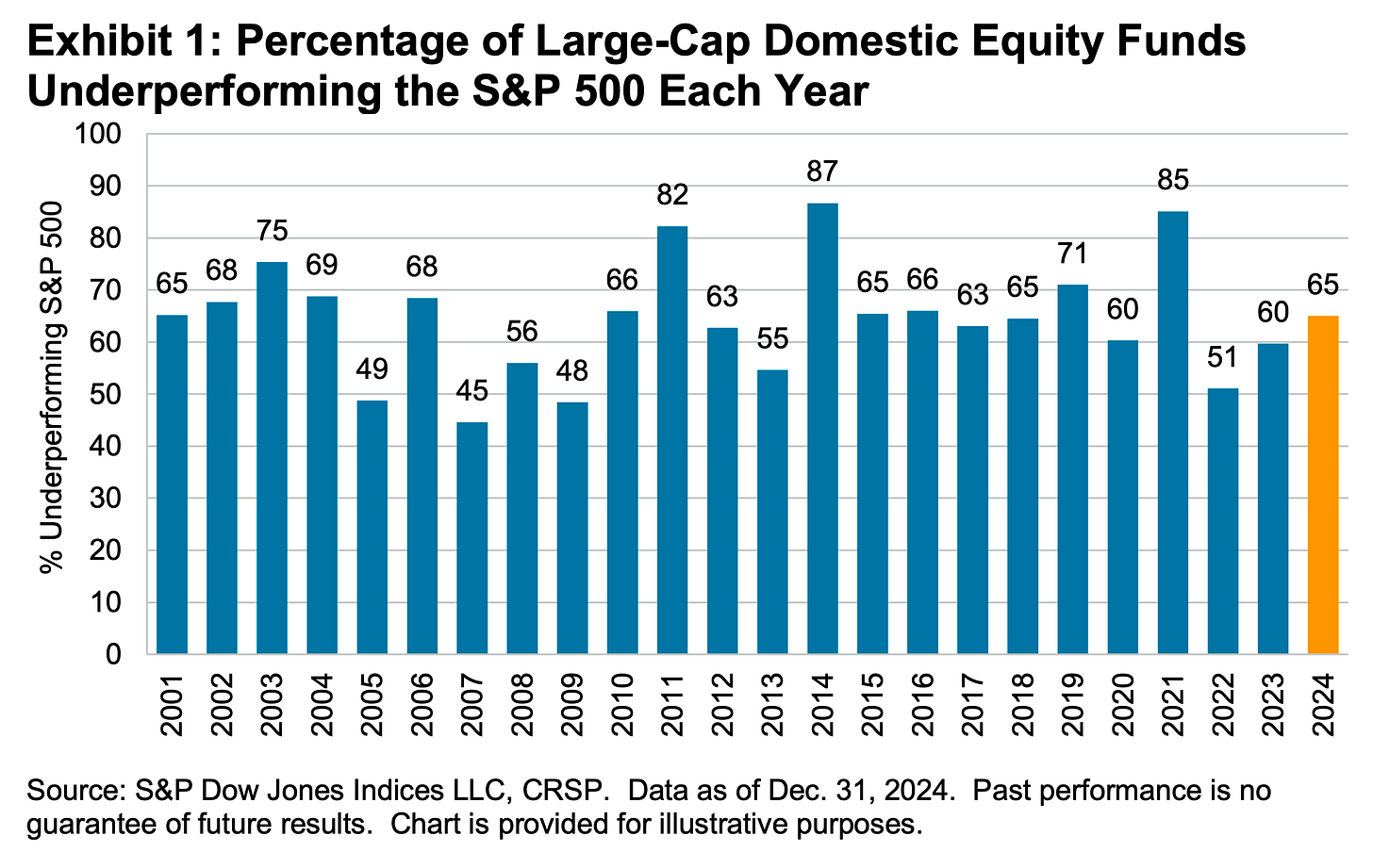
Proof that 'past performance is no guarantee of future results' 📊
Even if you are a fund manager who generated industry-leading returns in one year, history says it’s an almost insurmountable task to stay on top consistently in subsequent years. According to S&P Dow Jones Indices, just 4.21% of all U.S. equity funds in the top half of performance during the first year were able to remain in the top during the four subsequent years. Only 2.42% of U.S. large-cap funds remained in the top half
SPDJI’s report also considered fund performance relative to their benchmarks over the past three years. Of 738 U.S. large-cap equity funds tracked by SPDJI, 50.68% beat the S&P 500 in 2022. Just 5.08% beat the S&P in the two years ending 2023. And only 2.14% of the funds beat the index over the three years ending in 2024.

The odds are stacked against stock pickers 🎲
Picking stocks in an attempt to beat market averages is an incredibly challenging and sometimes money-losing effort. Most professional stock pickers aren’t able to do this consistently. One of the reasons for this is that most stocks don’t deliver above-average returns. According to S&P Dow Jones Indices, only 19% of the stocks in the S&P 500 outperformed the average stock’s return from 2001 to 2025. Over this period, the average return on an S&P 500 stock was 452%, while the median stock rose by just 59%.
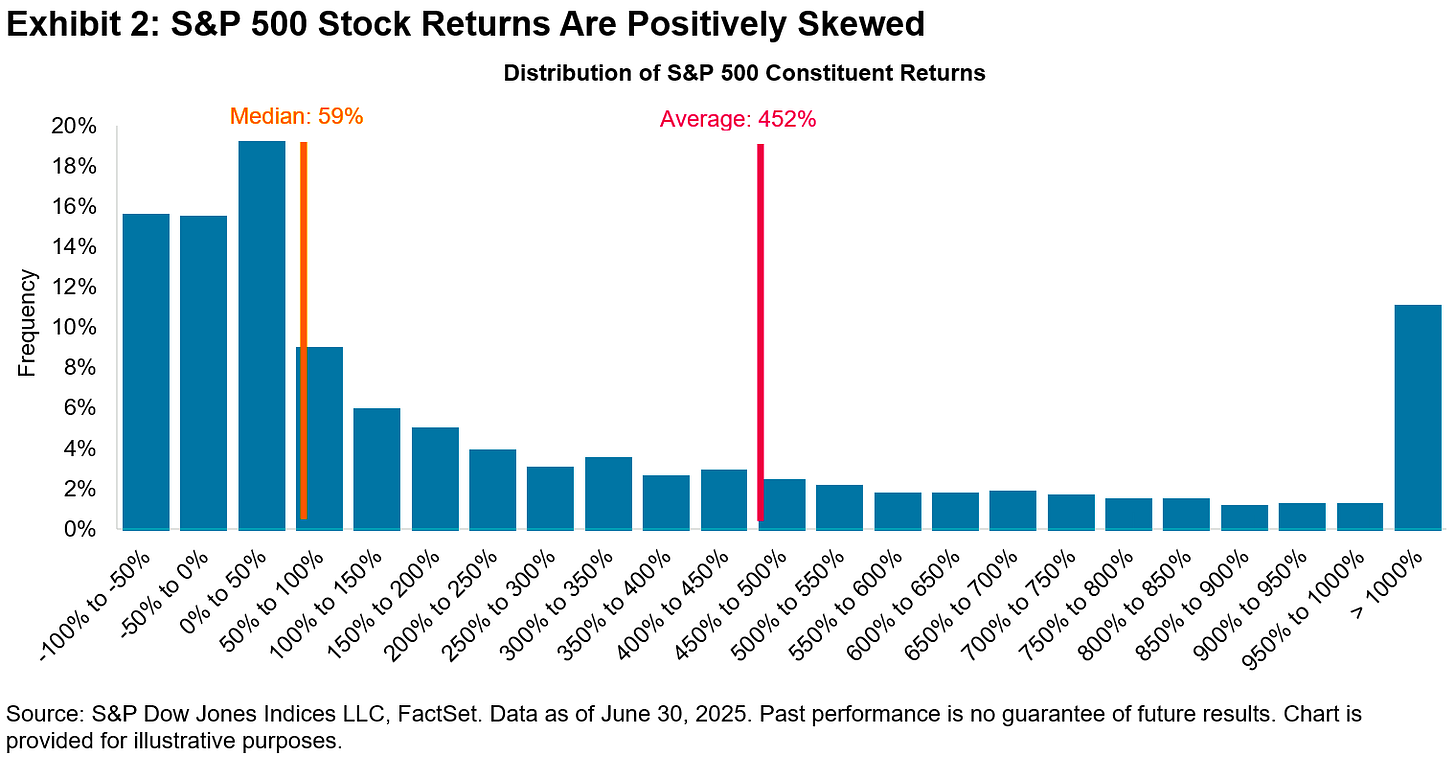


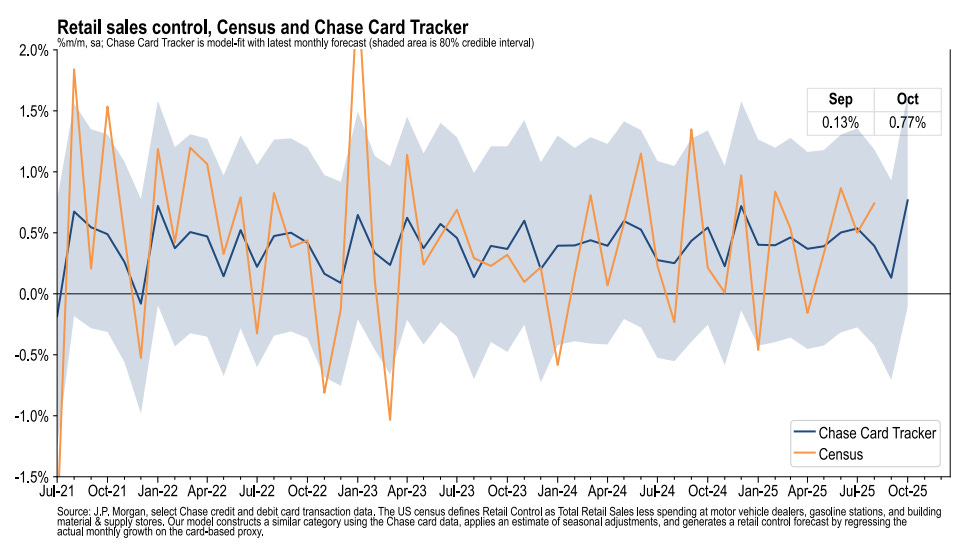
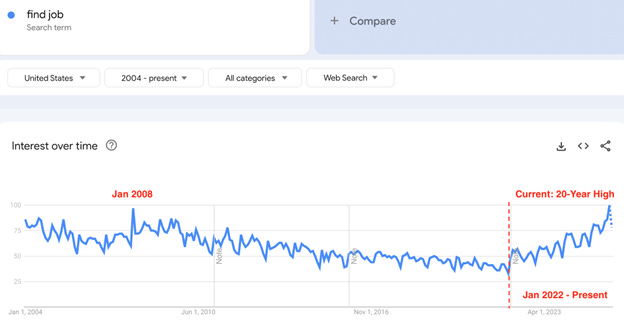
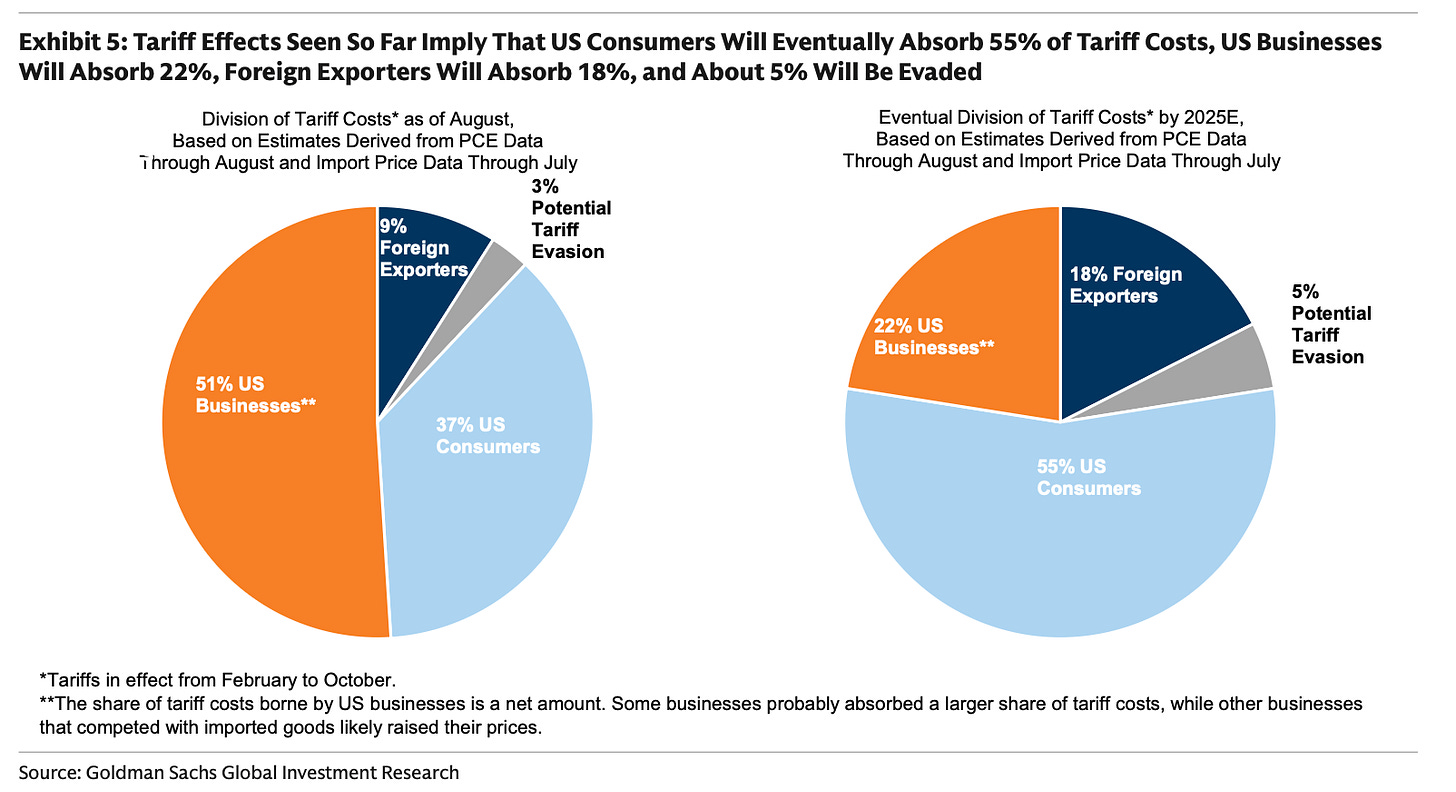
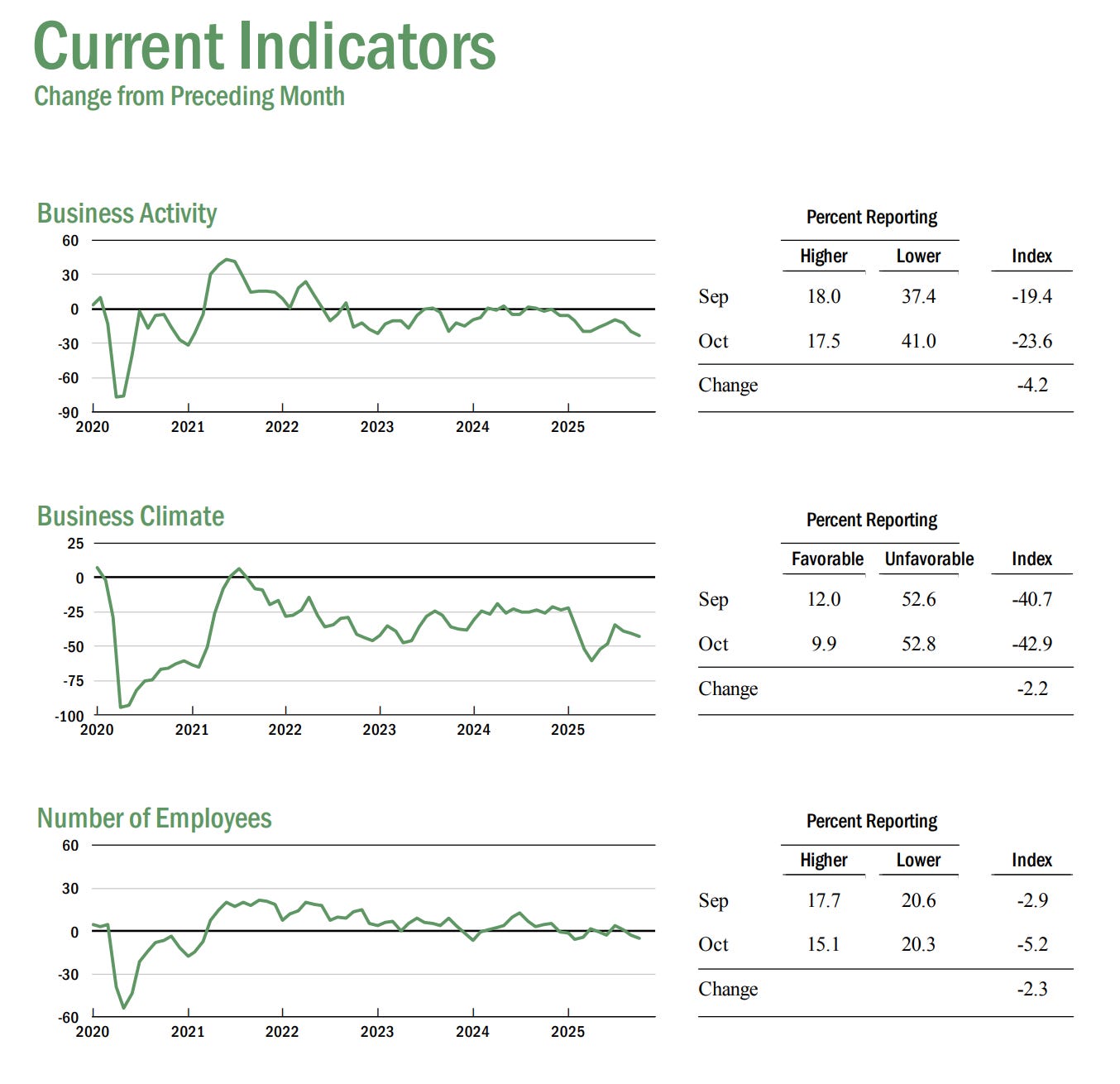
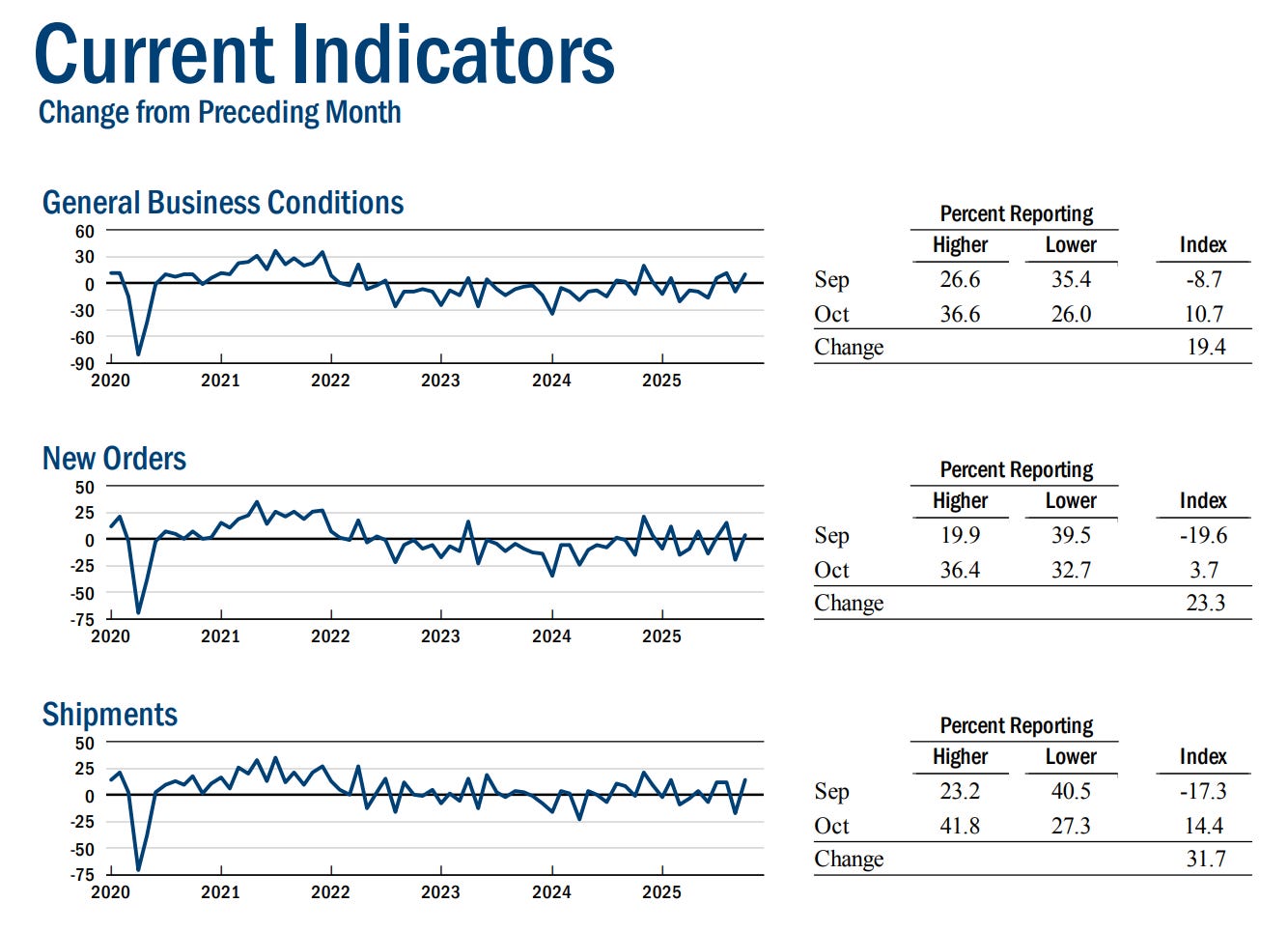
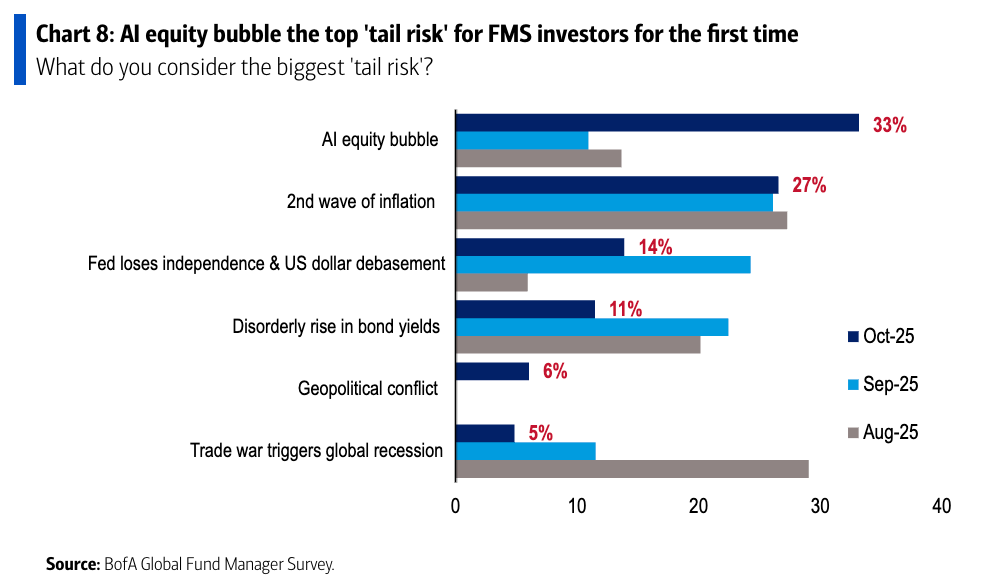
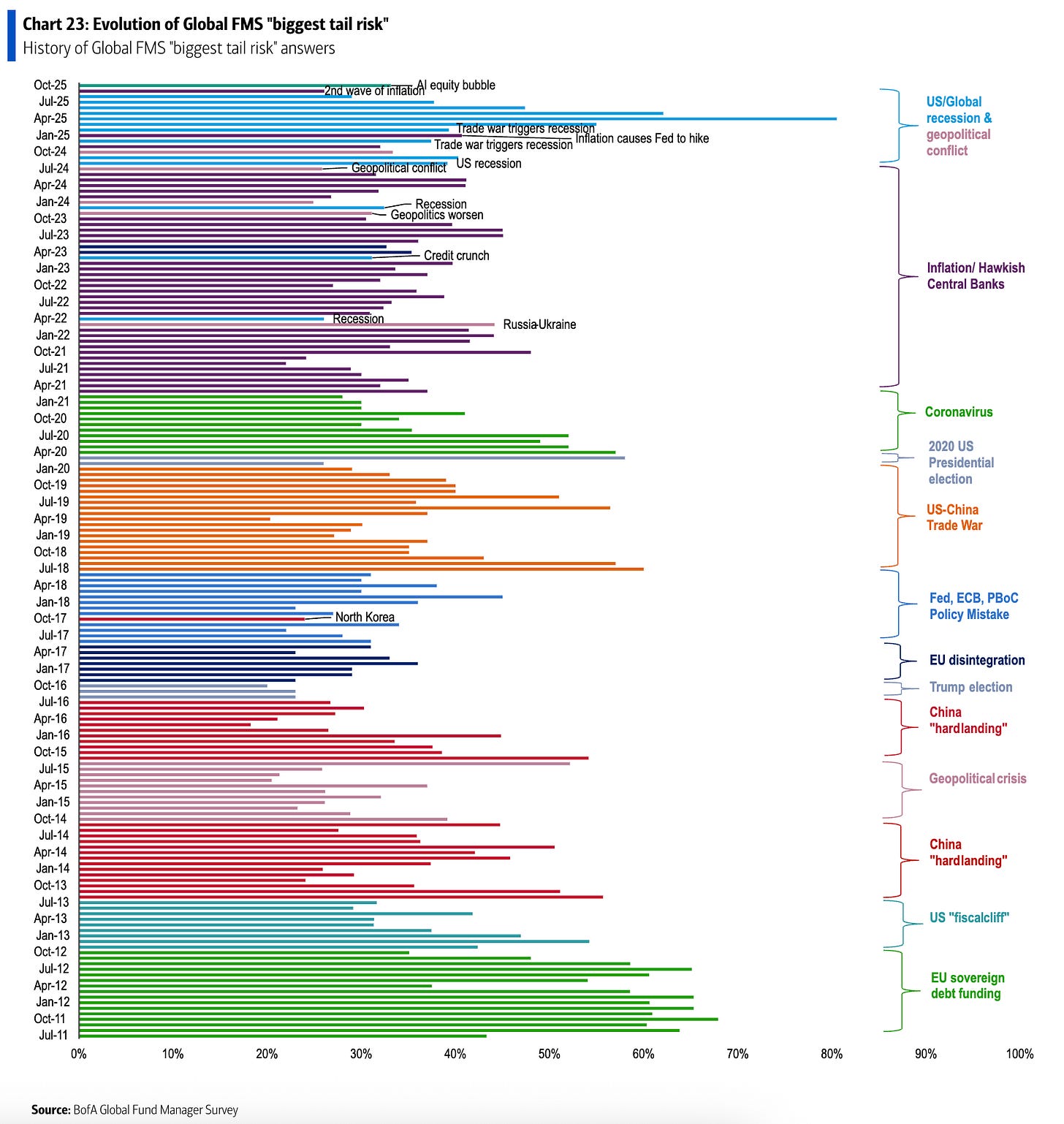
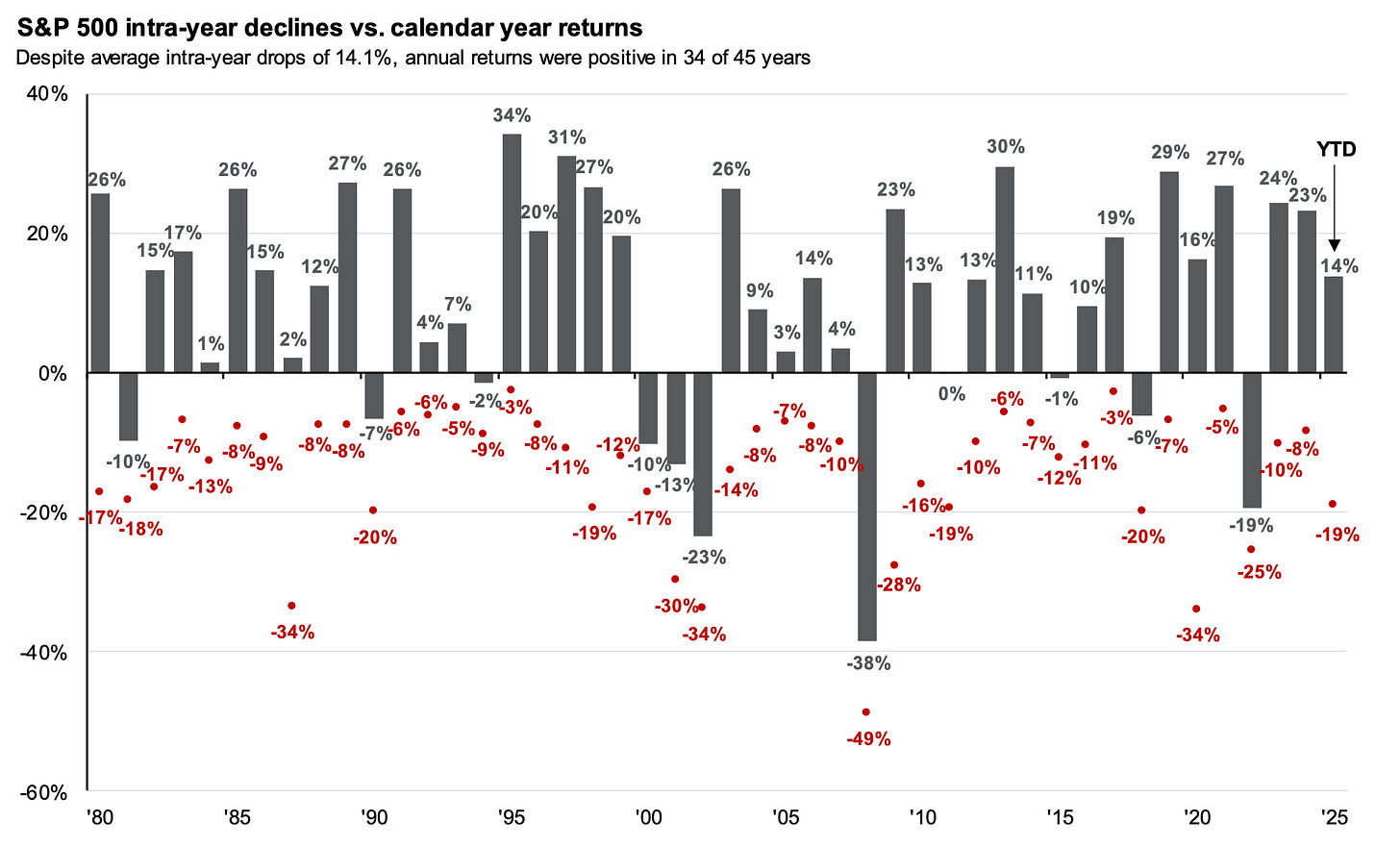
They should put a dot on the blue side to indicate when the market broke even from the downturn, indicating a new market high.